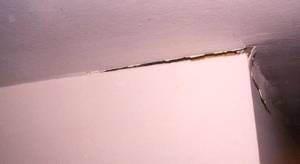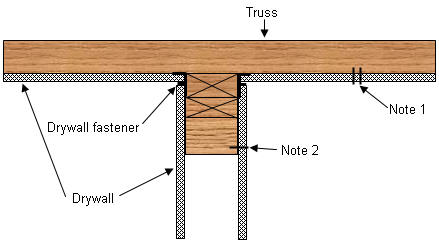Problem: Wall-ceiling separation
Cause: Truss uplift.
Differential shrinkage can occur between the top and bottom chords due to temperature and moisture conditions. Because of this the bottom chord bends upward, pulling the ceiling drywall and occasionally the interior partitions with it a shown in Figure 24.

Figure 24 - Wall-Ceiling Separation Due To Truss Uplift.
Solutions: Minimize moisture in the attic, use kiln dried lumber for trusses, float drywall corners, use mono trusses in place of full-span trusses or install resilient channels perpendicular to trusses before you apply drywall as shown in Figure 25.

Figure 25 - Mono Truss
- The greater the amount of moisture in the attic the greater the potential for the roof truss to take on this moisture. Reduce the amount of moisture that enters the attic by using an effective air-barrier system. Ventilation of the attic can also help keep moisture levels under control.
- Trusses should be fabricated using kiln-dried wood. Store trusses properly and cover them as soon as they are installed so that they do not take on moisture.
- Floating the corners will hide the effects of truss uplift as shown in Figure 26. This technique involves keeping the fasteners for both the ceiling drywall and the partition wall drywall away from the corner joint. This uses the natural flexibility of the drywall to allow uplift of 2 to 3 inches (50 to 75 mm) to occur without cracking the corner joint. Recommended float distance are 12 inches (300 mm) for 1/2 inches drywall ceilings; 16 inches (400 mm) for 5/8 inch (16 mm) drywall ceilings; and 8 inches (200 mm) for partition walls. With floating corners, double the first row of fasteners to prevent pull through. The stress on corner joints can be reduced by holding the ceiling drywall to the top plate with drywall clips, wood blocks or with wider top plates and strapping.

Figure 26 - Floating Drywall Intersection Along Partitions
Note 1: 12 inches (300 mm) distance from wall to screws or double nailing.
Note 2: 7 inches (180 mm) from ceiling drywall to first nail or screw on wall drywall.
Additional information on roof truss uplift
Additional information on roofs and roofing
